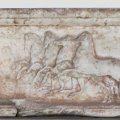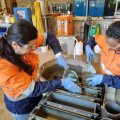Children living with their mothers in Australian prisons are subjected to prison practices including daily 'muster' parades and lock-ins, according to research undertaken at the University of Queensland.
School of Education PhD graduate Dr Ann Farrell said the study of prisons in Queensland, New South Wales, Victoria and England found they failed to meet the needs of incarcerated women and their children.
Dr Farrell's study, which she completed as part of her PhD, focused on mothers and their children aged from birth to eight years and included more than 130 interviews with inmates and staff in nine custodial centres.
They included the Women's Correctional Centre and the Helen Jones Community Corrections Centre in Queensland, the Mulawa Correctional Centre and Norma Parker Correctional Centre in New South Wales, Fairlea and Tarrengower in Victoria and Holloway, Styal and Askham Grange in the United Kingdom.
Victoria permitted children up to pre-school age to remain with their mothers, while Queensland had no specific upper age limit, Dr Farrell said. New South Wales did not allow children in custody with their mothers.
At the time of Dr Farrell's study there were 28 children in full-time custody with their mothers.
Dr Farrell found 85 per cent of inmate women were mothers of dependent children and most were the heads of single parent households serving sentences of less than six months for crimes against property.
In prisons 'built by men, for men' few allowances were made for women and even fewer for mothers either looking after infants or being visited by older children, she said.
She criticised prison authorities for continuing practices which worked against the rehabilitation and reintegration of women inmates into society claiming they were carried out for 'ease of staff'.
'Some prisons persist with lock-ins where inmates and their children are in cells from 9pm to 6am, in some cases without powerpoints for heating bottles or preparing food.
'This is problematic for a mother with a distressed infant and for other inmates who are confined to close quarters.'
Dr Farrell said visiting areas were also alien environments, especially in highly fortified, maximum security prisons where children were sometimes subjected to security checks by uniformed guards.
And while the maintenance of family ties was seen by both inmates and their families as important for the rehabilitation of the mother and the welfare of the children, the social stigma attached to incarceration was often overwhelming.
Many women told their children they were going to hospital or on holiday while some older children refused to visit their mothers in prison.
'Family policies' were also needed to be put in place to ensure children living with mothers within the prison system were not placed at unnecessary risk from 'the practice of institutionalisation', she said.
'My argument is if governments decide children should be allowed in custody, then they should provide facilities appropriate to the needs of young children.
'This involves training of custodial staff who supervise family visits and who work in the wings housing mothers and children.
'If this is seen as inappropriate or not affordable for a small clientele, then the logical policy implication is that children should not be assigned to prisons in conditions which are inadequately resourced.'
Dr Farrell, who is currently carrying out research at Queensland University of Technology's Centre for Applied Studies in Early Childhood is now researching kinship networks for women in Queensland prisons through the Australian Rotary health Foundation and is also an adviser to the New South Wales Parliamentary Standing Committee on Mothers and Children in Custody.
For further information phone Dr Ann Farrell on (07) 3864 3603.
.jpg)



